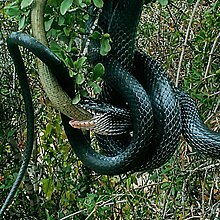Arrow snake
| Arrow snake | ||||||||||||
|---|---|---|---|---|---|---|---|---|---|---|---|---|

Arrow snake ( Dolichophis jugularis ) |
||||||||||||
| Systematics | ||||||||||||
|
||||||||||||
| Scientific name | ||||||||||||
| Dolichophis jugularis | ||||||||||||
| ( Linnaeus , 1758) |
The arrow snake ( Dolichophis vein , Syn. : Coluber jugularis ), also Jochnatter or Spring Natter is a non-toxic snake from the family of snakes . It was first described in 1758 by the Swedish scientist Carl von Linné and is also known as Engl. Large Whip Snake and franz. Serpent fouet grand known.
Occurrence

The distribution area of the arrow snake includes eastern and southeastern Turkey , parts of Georgia and Jordan , Syria , northern Iraq and Iran as well as Lebanon , Palestine and Israel . It is mostly found in dry and open landscapes. This includes steppes , hilly landscapes with bush vegetation and light ground vegetation, scree slopes and pastures with many thorn bushes, vineyards , gardens , ruins and old, empty houses. It inhabits heights in the mountains of up to 2,000 meters.
features
The arrow snake is one of the large snake species with up to 250 cm, it reaches an average of 150 cm. Due to the very elongated tail, the body, which is relatively thick for an adder, still looks very slim, whereby the head hardly stands out from the trunk .
It has smooth, unkeeled body scales. The center of the body is surrounded by 19 back rows of scales, are located at the top two reins signs ( Loreale ), two Voraugenschilder ( Praeocularia ), two or three rear eyes signs ( Postocularia ) and a lower eye shield ( Soboculare ) at the front edge of the eye. It also has eight, sometimes seven, upper lip shields ( supralabials ).
Most specimens are black on the upper side, less often gray, colored - the underside and throat are light to dark red. Young animals have a striking pattern of spots, which, however, disappear after three to four years.
Way of life

The snake is diurnal and an excellent climber, but can be found more often on the ground. She takes in the morning and late afternoon, before and after eating, extensive sunbathing during which she remains awake and one when approaching people quickly fled. If you corner them or try to grab them, a violent and painful bite follows. Although the arrow snake is non-toxic, the bite site should still be disinfected to avoid infections and inflammation . In the terrarium this species loses its shyness and aggressiveness .
It hibernates over the cool months in a sheltered and cold-resistant hiding place .
Reproduction
When the mating season begins in spring , the females attract the males using pheromones (sexual attractants). During sexual intercourse, the partners entwine and the male inserts his everted hemipenis into the female's cloaca to fertilize the eggs there. If fertilization is successful, the female lays 5 to 15 eggs a few weeks later in a damp hiding place, under a pile of stones or in a cave. The young hatch from early to mid-September.
nutrition
Especially small mammals such as rats and mice , small birds , lizards and other snakes fit into the prey pattern of the arrow snake . It is also not afraid of the water as a hunting ground, where it dives for frogs and small amphibians . The adder grabs its prey with one bite and strangles it.
Systematics
Until genetic analyzes had shown otherwise, the arrow snake, like many other larger snakes that specialize in hunting nimble prey such as lizards, was placed in the genus of the furious snake ( Coluber ). After it had been shown that the species of the genus Coluber did not have a common ancestral form, the species of the ancient world were moved to the genera Dolichophis , Hierophis , Hemerophis , Hemorrhois and Platyceps , among others . Like many other genera in the Colubridae family, the Dolichophis systematics is still under discussion and is the subject of current research.
The following cladogram shows the relationships between the genus Dolichophis according to Baker et al. The position of Dolichophis cypriensis is not yet known.
|
|
|
||||||||||||||||||
|
|
There are currently three subspecies of the arrow snake:
- Dolichophis jugularis jugularis
- Dolichophis jugularis asianus
- Dolichophis jugularis cypriacus
Danger
In addition to the natural predators such as birds of prey , foxes and martens , cars, pesticides and pets , especially domestic cats, pose a great danger. It also happens again and again that farmers kill the snakes, imagining they have a poisonous snake in front of them, even though they do Snake is harmless and useful to farmers as it eats grain pests such as mice and rats .
The arrow snake is on the red list of the IUCN classified as uncritical ( "Least Concern", LC).
literature
- Ulrich Gruber: The snakes in Europe and around the Mediterranean. Franckh Kosmos Verlag, ISBN 3-440-05753-4 .
Individual evidence
- ↑ a b Z. T. Nagy, R. Lawson, U. Joger, M. Wink: Molecular systematics of racers, whipsnakes and relatives (Reptilia: Colubridae) using mitochondrial and nuclear markers . In: Journal of Zoological Systematics and Evolutionary Research . tape 42 , no. 3 . Blackwell Verlag, 2004, ISSN 0947-5745 , p. 223–233 , doi : 10.1111 / j.1439-0469.2004.00249.x ( uni-heidelberg.de PDF; 200 kB). uni-heidelberg.de ( Memento of the original from April 2, 2015 in the Internet Archive ) Info: The archive link was inserted automatically and has not yet been checked. Please check the original and archive link according to the instructions and then remove this notice.
- ↑ Dolichophis jugularis in The Reptile Database ; Retrieved January 22, 2011.
- ↑ Mohammad Abu Baker, Lina Rifai, Ulrich Joger, Zoltan T. Nagy, Michael Wink, Zuhair Amr: Occurrence of Coluber (Hierophis) schmidti Nikolsky, 1909 in Jordan (Squamata: Serpentes: Colubridae) . In: Herpetozoa . tape June 15 , 2002, ISSN 1013-4425 , pp. 29–36 ( uni-heidelberg.de PDF).
- ↑ Bayram Göçmen, Mehmet K. Atatür, Abidin Budak, Hasan Bahar, Mehmet Zülfü Yildiz, Nurşen Alpagut-Keskin: Taxonomic notes on the snakes of Northern Cyprus, with observations on their morphologies and ecologies . In: Animal Biology . tape 59 , 2009, p. 1-30 , doi : 10.1163 / 157075609X417062 .
- ↑ Ahmad Mohammed Mousa Disi, Yehudah Werner, Varol Tok, Ismail H. Ugurtas, Murat Sevinç, Petros Lymberakis, Souad Hraoui-Bloquet, Riyad Sadek, Pierre-André Crochet, Sherif Baha El Din, Uğur Kaya: Dolichophis jugularis . In: IUCN Red List of Threatened Species . Version 2010.2, 2008 ( iucnredlist.org [accessed August 23, 2010]).
